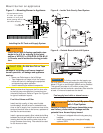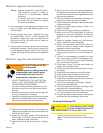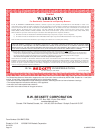
Page 20 6104BAFG R0
Step 4: Recheck smoke level. It should be Zero.
This procedure provides a margin of
reserve air to accommodate variable
conditions.
If the draft level has changed, recheck
the smoke and CO
2
levels and readjust
the burner if necessary
Once combustion is set, tighten all fasteners on air
band, air shutter and head adjusting plate or es-
cutcheon plate.
Burner equipped with cover - Reinstall the cover
and repeat Steps 2 and 4. If CO
2
increases (O
2
decreases), remove the cover and adjust the air
setting so the CO
2
(O
2
) with cover on meets re-
quirements of Step 3.
Start and stop the burner several times to ensure
satisfactory operation. Test the primary control and
all other appliance safety controls to verify that they
function according to the manufacturer’s specifi ca-
tions.
Perform regular maintenance
•
•
4.
5.
6.
DO NOT TAMPER WITH THE UNIT OR CON-
TROLS - CALL YOUR QUALIFIED SERVICE
TECHNICIAN OR SERVICEMAN.
To ensure continued reliable operation, a quali-
fi ed service technician must service this burner
annually.
More frequent service intervals may be required
in dusty or adverse environments.
Operation and adjustment of the burner requires
technical training and skillful use of combustion
test instruments and other test equipment.
y
y
y
y
Tampering with or making incorrect
adjustments could lead to equip-
ment malfunction and result in
asphyxiation, explosion or fi re.
WARNING
!
Annual Professional Ser-
vice Required
Verify the nozzle is the one originally specifi ed by
the appliance manufacturer and replace the noz-
zle with one having the exact specifi cations from
the same manufacturer.
Clean and inspect the electrodes for damage, re-
placing any that are cracked or chipped.
Check electrode tip settings. Replace electrodes
if tips are rounded.
Inspect the igniter spring contacts. Clean or re-
place if corroded.
Clean the cad cell grid surface, if necessary.
Make sure Low Firing Rate Baffl e is in place if
required for the burner application. Omitting the
baffl e can result in unacceptable burner combus-
tion.
Inspect all gaskets. Replace any that are dam-
aged or would fail to seal adequately.
Inspect the combustion head and air tube. Re-
move any carbon or foreign matter. Replace all
damaged units with exact parts.
Clean the blower wheel, air inlet, air guide, burner
housing and static plate of any lint or foreign ma-
terial.
If motor is not permanently lubricated, oil motor
with a few drops of SAE 20 nondetergent oil at
each oil hole. DO NOT over oil motor. Excessive
oiling can cause motor failure.
Check motor current. The amp draw should not
exceed the nameplate rating.
Check all wiring for secure connections or insula-
tion breaks.
Check the pump pressure and cutoff function.
Check primary control safety lockout timing.
Check ignition system for proper operation.
Inspect the vent system and chimney for soot ac-
cumulation or other restriction.
Clean all fl ue passages and fl ue pipe. Replace
corroded or damaged pipes.
Clean the appliance thoroughly according to the
manufacturer’s recommendations.
Check the burner performance. Refer to the sec-
tion “Set combustion with test instruments”.
It is good practice to make a record of the service
performed and the combustion test results.
Shutting the Burner Off
IF THE BURNER IS SHUT DOWN
FOR AN EXTENDED PERIOD OF
!!
CAUTION
TIME, ALWAYS KEEP THE VALVE SHUT OFF.
Perform regular maintenance
Replace the oil supply line fi lter. The line fi lter car-
tridge must be replaced to avoid contamination of
the fuel unit and nozzle.
Inspect the oil supply system. All fi ttings should
be leak-tight. The supply lines should be free of
water, sludge and other restrictions.
Remove and clean the pump strainer if applica-
ble.
Turn off all electric power to the burner.
Note: There could be more than one disconnect
switch.


















